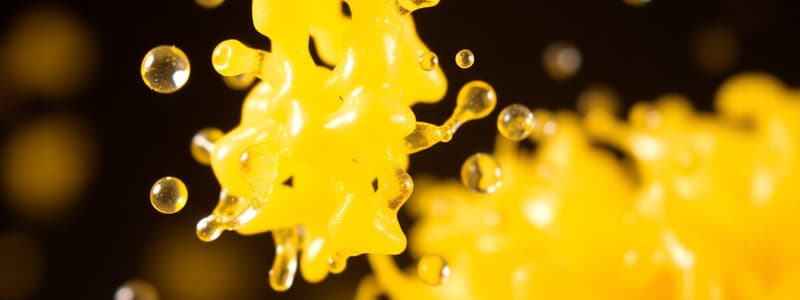Podcast
Questions and Answers
What is formed when phosphoric acid reacts with ammonium molybdate in the presence of HNO3?
What is formed when phosphoric acid reacts with ammonium molybdate in the presence of HNO3?
- A white precipitate
- A red solution
- A yellow precipitate (correct)
- No precipitate forms
What occurs when KSCN is added to saliva and mixed with FeCl3 and HCl?
What occurs when KSCN is added to saliva and mixed with FeCl3 and HCl?
- A blue precipitate forms
- A colorless solution forms
- No visible reaction occurs
- A brick-red precipitate appears (correct)
What is the concentration range of SCN- ions found in saliva?
What is the concentration range of SCN- ions found in saliva?
- 0.01-0.03 mg% (correct)
- 0.05-0.10 mg%
- 0.50-1.00 mg%
- 0.20-0.30 mg%
How does the concentration of KSCN in smokers' saliva compare to that in non-smokers' saliva?
How does the concentration of KSCN in smokers' saliva compare to that in non-smokers' saliva?
What product results from the proteic metabolism as indicated in the content?
What product results from the proteic metabolism as indicated in the content?
What is the final digestion product of starch?
What is the final digestion product of starch?
Which color indicates the presence of amylodextrines after adding Lugol solution?
Which color indicates the presence of amylodextrines after adding Lugol solution?
What temperature condition affects the activity of salivary amylase the most?
What temperature condition affects the activity of salivary amylase the most?
Which statement describes the effect of boiled saliva on starch digestion?
Which statement describes the effect of boiled saliva on starch digestion?
What is observed after 30 minutes of starch digestion with fresh saliva?
What is observed after 30 minutes of starch digestion with fresh saliva?
Which reagent is used to identify maltose in the digestion process?
Which reagent is used to identify maltose in the digestion process?
What color does erythrodextrines produce when reacting with Lugol solution?
What color does erythrodextrines produce when reacting with Lugol solution?
What is the primary factor that influences salivary amylase activity?
What is the primary factor that influences salivary amylase activity?
What is the primary role of NaOH in the Trommer reaction with maltose?
What is the primary role of NaOH in the Trommer reaction with maltose?
What indicates the presence of calcium ions in saliva when treated with ammonium oxalate?
What indicates the presence of calcium ions in saliva when treated with ammonium oxalate?
What is observed when maltose is reacted with CuSO4 solution in an alkaline pH during the Trommer reaction?
What is observed when maltose is reacted with CuSO4 solution in an alkaline pH during the Trommer reaction?
Which of the following statements about phosphorus detection in saliva is correct?
Which of the following statements about phosphorus detection in saliva is correct?
Why is boiling necessary during the Trommer reaction?
Why is boiling necessary during the Trommer reaction?
What type of crystals is associated with the presence of calcium oxalate precipitates in saliva?
What type of crystals is associated with the presence of calcium oxalate precipitates in saliva?
What might be a cause for a negative Trommer reaction when testing maltose?
What might be a cause for a negative Trommer reaction when testing maltose?
Which component is critical for the precipitation of phospho ammonium molybdate in saliva testing?
Which component is critical for the precipitation of phospho ammonium molybdate in saliva testing?
Flashcards
Ammonium phosphomolybdate formation
Ammonium phosphomolybdate formation
A chemical reaction involving sodium phosphate, ammonium molybdate, and nitric acid. It produces a yellow precipitate, which is ammonium phosphomolybdate.
Potassium sulfocyanate (KSCN)
Potassium sulfocyanate (KSCN)
A chemical compound with the formula KSCN, commonly found in saliva. It is a detoxification product resulting from protein metabolism or fruit ingestion.
Ferric sulfocyanate formation
Ferric sulfocyanate formation
A chemical reaction that occurs when potassium sulfocyanate (KSCN) reacts with ferric chloride (FeCl3) in the presence of hydrochloric acid (HCl). It produces a brick-red precipitate known as ferric sulfocyanate.
KSCN concentration in smokers vs non-smokers
KSCN concentration in smokers vs non-smokers
Signup and view all the flashcards
Minerals evidence in saliva
Minerals evidence in saliva
Signup and view all the flashcards
Trommer's Reaction
Trommer's Reaction
Signup and view all the flashcards
Role of NaOH in Trommer's Reaction
Role of NaOH in Trommer's Reaction
Signup and view all the flashcards
Red Precipitate in Trommer's Reaction
Red Precipitate in Trommer's Reaction
Signup and view all the flashcards
Calcium Oxalate Precipitate
Calcium Oxalate Precipitate
Signup and view all the flashcards
Calcium Oxalate Crystal Shape
Calcium Oxalate Crystal Shape
Signup and view all the flashcards
Yellow Precipitate in Phosphate Test
Yellow Precipitate in Phosphate Test
Signup and view all the flashcards
Role of Nitric Acid in Phosphate Test
Role of Nitric Acid in Phosphate Test
Signup and view all the flashcards
Ammonium Molybdate in Phosphate Test
Ammonium Molybdate in Phosphate Test
Signup and view all the flashcards
What is the role of saliva in starch digestion?
What is the role of saliva in starch digestion?
Signup and view all the flashcards
What are the intermediate products of starch digestion by saliva?
What are the intermediate products of starch digestion by saliva?
Signup and view all the flashcards
How can we identify the different stages of starch digestion?
How can we identify the different stages of starch digestion?
Signup and view all the flashcards
What is the final product of starch digestion by saliva?
What is the final product of starch digestion by saliva?
Signup and view all the flashcards
Why does boiling saliva stop starch digestion?
Why does boiling saliva stop starch digestion?
Signup and view all the flashcards
What factors influence the activity of salivary amylase?
What factors influence the activity of salivary amylase?
Signup and view all the flashcards
What does the time factor demonstrate in the starch digestion experiment?
What does the time factor demonstrate in the starch digestion experiment?
Signup and view all the flashcards
What is the purpose of the control tube (T1) in the starch digestion experiment?
What is the purpose of the control tube (T1) in the starch digestion experiment?
Signup and view all the flashcards
Study Notes
Digestive Effect of Saliva on Starch
- Starch digestion begins in the mouth, mixing with saliva containing ptyalin.
- Starch breaks down into shorter polysaccharides (amylodextrins, erythrodextrines, acrodextrines), and finally maltose (a disaccharide).
- Each step can be identified using Lugol's solution (identification reaction).
- The final product of starch digestion is maltose, identifiable using the Trommer reaction.
- Objective: Understand salivary amylase action, its demonstration, and factors influencing its activity (temperature, pH).
Materials
- 1% Starch solution
- 1% Iodine (Lugol's reagent) (1:2:300 iodine, potassium, water)
- Test tubes
- Graduated cylinders
- Saliva
- Sodium hydroxide (NaOH)
- Copper(II) sulfate (CuSO4) 10% solution
- Filter paper
Procedure
- Use clean test tubes, adding 5ml of starch solution and 2-3 drops of Lugol's solution (control).
- Experiment with saliva: boiled saliva (T2), fresh saliva (T3), fresh saliva, 5-7 min, then heat (T4), fresh saliva, 15-20 min, then heat (T5) and fresh saliva, 30 minutes (T6).
- Observe color changes at each stage of starch digestion:
- Amylodextrines: blue-violet (T3)
- Erythrodextrines: pink-violet (T4)
- Acrodextrines: colourless (T5)
- Maltose: colourless (T6)
Trommer Reaction
- Principle: Maltose reduces Copper(II) sulfate (CuSO4) to cuprous oxide in alkaline conditions.
- Materials: Test tubes, Bunsen burner, NaOH 20% solution, CuSO4 10% solution, starch solution.
- Procedure: Mix maltose solution and NaOH, add CuSO4 solution dropwise, generating a blue precipitate. Boil the solution to form a red-colored copper precipitate.
Calcium in Saliva
- Materials: Test tube, ammonium oxalate 10% solution, saliva, microscope
- Procedure: Add ammonium oxalate to saliva, forming a white precipitate in the presence of calcium. Examine octahedral crystals under a microscope (related to calcium oxalate formation).
Phosphorus in Saliva
- Materials: Test tubes, gas burner, HNO3 (nitric acid), (NH4)2MoO4 (ammonium molybdate)
- Procedure: Add HNO3 and ammonium molybdate to saliva. Heat carefully. Formation of a yellow precipitate indicates phosphorus (phospho ammonium molybdate).
Potassium Thiocyanate in Saliva
- Materials: Test tubes, FeCl3 (ferric chloride) 3%, HCl (hydrochloric acid) 10% solution, saliva
- Procedure: Add HCl and ferric chloride to saliva. A brick-red precipitate of ferric thiocyanate indicates the presence of potassium thiocyanate. Higher levels of thiocyanate are found in the saliva of smokers.
Studying That Suits You
Use AI to generate personalized quizzes and flashcards to suit your learning preferences.



